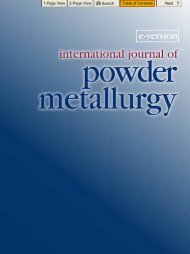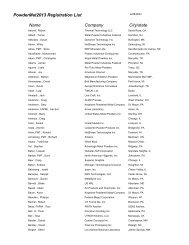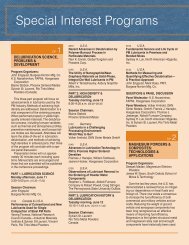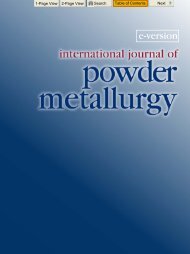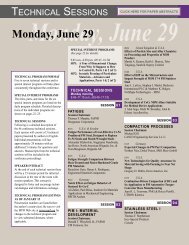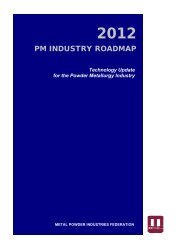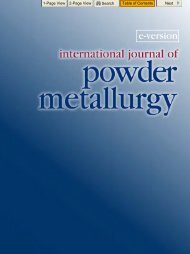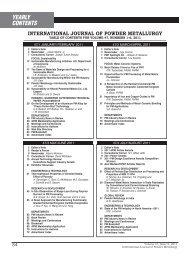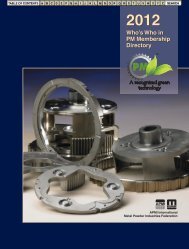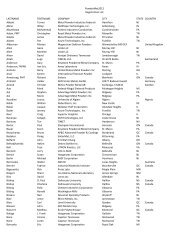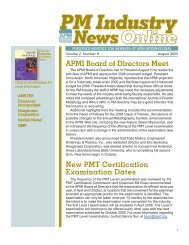E-IJPM: Vol. 44/4 - MPIF
E-IJPM: Vol. 44/4 - MPIF
E-IJPM: Vol. 44/4 - MPIF
Create successful ePaper yourself
Turn your PDF publications into a flip-book with our unique Google optimized e-Paper software.
POWDER METALLURGY IN INDIA<br />
42<br />
2010. Automotive firms such as Ford India and<br />
Honda Siel, along with domestic firms such as<br />
Ashok Leyland and Maruti Suzuki, have spent a<br />
total of $80 million.10<br />
PM EDUCATION<br />
PM courses are taught in engineering schools<br />
having a Metallurgical/Materials Engineering<br />
branch. In other disciplines, PM is included as a<br />
part of manufacturing processes courses. The<br />
rigor of structure/properties/performance relationships<br />
in PM processing is invariably dealt with<br />
in the metallurgical/materials engineering discipline.<br />
The latest publication of the author,11 based<br />
on these a relationships, has received favorable<br />
reaction. From the beginning, the Indian Institute<br />
of Technology, Kanpur, contributed to the teaching<br />
of PM in a quantitative and design-oriented mode.<br />
Elective courses were also developed at both the<br />
undergraduate and postgraduate levels; these<br />
include Sintering and Sintered Products; Sintered<br />
Tool Materials, and Advances in Powder<br />
Metallurgy. The Indian Institute of Technology,<br />
Mumbai, which was active in PM education, is of<br />
late emphasizing ceramics. The Information<br />
Technology (IT) boom in India has been somewhat<br />
of a detriment to the “hard core” engineering disciplines.<br />
Students migrate to the IT industries<br />
because of lucrative salaries, and neither the manufacturing<br />
industries nor the government have<br />
any clear plan to mitigate the challenge this poses.<br />
PMAI<br />
The Powder Metallurgy Association of India<br />
(PMAI), founded in 1973 at the initiative of R.V.<br />
Tamhankar, organizes annual technical meetings<br />
and refresher courses for personnel from the PM<br />
industry. In early 2008, the 34th Annual<br />
Technical Meeting was held in Chennai. Of late,<br />
the established PM companies appear to show<br />
less enthusiasm for these professional events. The<br />
cemented carbide industries find an improved<br />
kinship with the Machine Tool Manufacturing<br />
Associations. The situation appears similar to<br />
that described by K.H. Roll in his extensive review<br />
of the first 50 years of the Metal Powder<br />
Industries Federation during the 1950s.12 Other<br />
organizations such as the Indian Ceramic Society<br />
and the Materials Research Society of India also<br />
offer scope and flexibility for participation from<br />
the PM community.<br />
CONCLUSIONS<br />
PM in India is developing at a steady rate, but<br />
one would like to see a quantum jump. There is<br />
enough scope to diversify into non-automotive PM<br />
parts, but this requires a vigorous campaign. In<br />
brief, the PM industry must strive for:<br />
• Alliances with strategic partners<br />
• Development of specialized products for key<br />
customers through enhanced application<br />
engineering<br />
• Improvement in supply capacity and a reduction<br />
in lead times<br />
• Improvement in consistency of quality<br />
through total quality management (TQM) and<br />
Six Sigma programs<br />
• Strengthening marketing initiatives<br />
• Comprehensive branding exercise<br />
• Training of technical manpower, particularly<br />
at the middle level<br />
• Interaction with global vendors<br />
REFERENCES<br />
1. G.S. Upadhyaya, “Status of Powder Metallurgy in India,”<br />
Powder Metall. Int., 1975, vol. 7, no. 4, pp. 197–200.<br />
2. G.S. Upadhyaya, “Powder Metallurgy in India,” Powder<br />
Metall. Int., 1986, vol. 18, no. 3, pp. 223–224.<br />
3. G.S. Upadhyaya, “Powder Metallurgy in India,” Int. J. of<br />
Powder Metall., 1988, vol. 24, no. 3, pp. 259–262.<br />
4. G.S. Upadhyaya, “Powder Metallurgy in India,” Int. J. of<br />
Powder Metall., 1990, vol. 26, no. 4, pp. 391–395.<br />
5. P.K. Johnson, “Growth Opportunities for Growth in<br />
India”, Int. J. of Powder Metall., 2007, vol. 43, no. 3, pp.<br />
9–13.<br />
6. D. Chenoy, Hindustan Times, February 26, 2008.<br />
7. Technology Roadmap by the Core Group on Automotive<br />
R&D, Office of the Principal Scientific Adviser, New Delhi,<br />
March 2006.<br />
8. P. Datta and G.S. Upadhyaya, “Sintered Duplex Stainless<br />
Steels from Premixes of 316L and 434L Powders,”<br />
Materials Chemistry and Physics, 2001, vol. 67, no. 1–3,<br />
p. 234–242.<br />
9. G.S. Upadhyaya, “Powder Metallurgy at Indian Institute of<br />
Technology, Kanpur,” Int. J. of Powder Metall., 1991, vol.<br />
27, no. 1, pp. 59–64.<br />
10. N. Mrinalini and S. Wakdian, “Foreign R&D Centres in<br />
India,: Is there any Positive Impact?”, Current Science,<br />
2008, vol. 94, no. 4, p. 452–458.<br />
11. G.S. Upadhyaya and A. Upadhyaya, Materials Science and<br />
Engineering, Anshan Ltd., Tunbridge Wells, Kent, U.K.,<br />
2007.<br />
12. K.H. Roll, “The First Fifty: A History of the First Half<br />
Century of the Metal Powder Industries Federation”, Fifty<br />
Years of Service to Powder Metallurgy 19<strong>44</strong>–1994, Metal<br />
Powder Industries Federation, Princeton, NJ, 1994. ijpm<br />
<strong>Vol</strong>ume <strong>44</strong>, Issue 4, 2008<br />
International Journal of Powder Metallurgy



